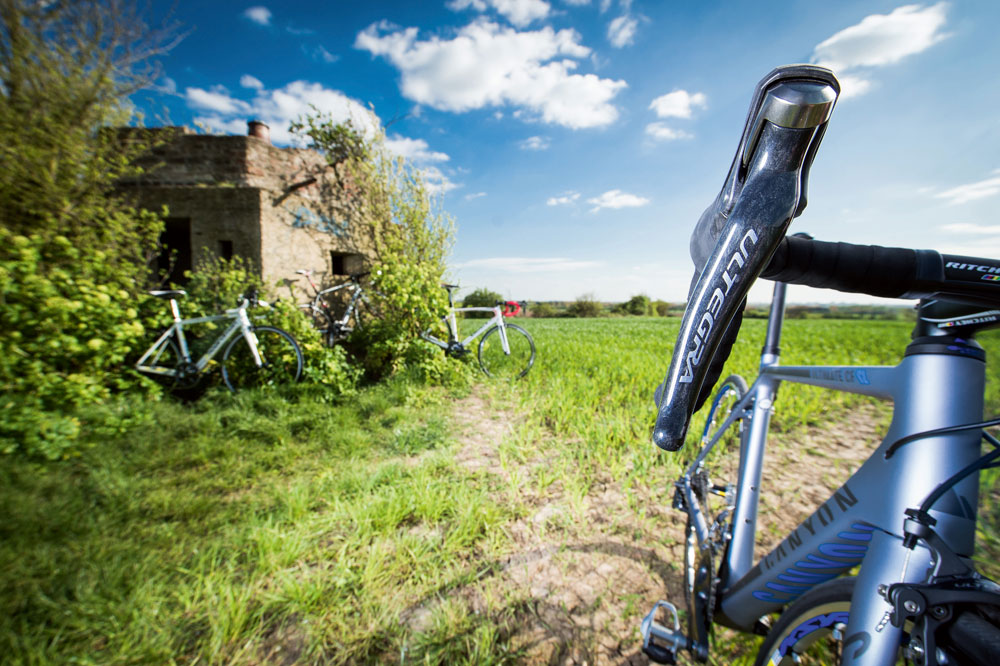Ultegra 11-speed race bikes

It’s all well and good if you’re a sponsored pro rider and you can have the best of the best — even the lowliest riders on a squad will have multiple bikes built with their sponsors’ finest products — but if you have to walk into a shop and buy your groupset, which one offers the best punch for your pound?
Trickle-down technology isn’t unique to cycling. Across technical equipment sectors, the top-of-the-range features eventually find their way down to the grass-roots.
Shimano and its top-tier groupset Dura-Ace took things up a notch (or rather sprocket) last year with the introduction of its 11-speed cassette.
Yet Shimano’s trickle-down of technology hasn’t been so much a trickle, more a torrent, recently; its new Ultegra 6800 received another sprocket and a four-arm asymmetric spider, similar to the Dura-Ace’s. It looks terrific, just like Dura-Ace, and the performance is similar too. It must be in the genes. The new Ultegra 6800 was unveiled last year but is only now starting to be seen on the new season’s bikes.
For this test, we’ve gathered together four of the cheapest carbon bikes on the UK market, with the aim not to compare them like for like, but rather to show what’s available. We also wanted to find out what the bike manufacturers think as to what works and why.
Meet the makers Alex Palmer of Canyon Bikes told us: “The new 11-speed Ultegra group allows us to deliver a race bike with one of the best price-performance ratios in the business. It not only looks just like Dura-Ace, its performance is incredibly close as well, giving customers the chance to have close to ProTour performance at a fraction of the price.”
Rudy Bouwmeester, PR and events manager at Shimano Europe, agrees: “The demand for Ultegra components remains strong, as it is a real value-for-money groupset. The market share of Ultegra, and Di2 specifically, is definitely growing, as is bike manufacturers’ use of Ultegra components.”
What’s new? What the latest version of Ultegra has over the superseded 6700 isn’t just another couple of gears; it’s also a bit skinnier, saving 35g on the previous model. In total, the new groupset comes in at around 2.3kg, depending on the size of the chainset and derailleurs, but has more gears and a vastly superior feel.
The levers have been refined to match Dura-Ace, and for the first time Ultegra receives a carbon lever. Shifting is much lighter, due to the new BC-R680 polymer-coated cables.
This coating, as well as decreasing friction, helps to provide greater modulation from the brakes.
Braking has been improved with a symmetrical, dual-pivot caliper — another of the developments passed down from Dura-Ace — which increases braking power by 10 per cent. There’s even an option for direct-mount Ultegra brakes,since this is the preferred design on more and more aero bikes.
One of the most recognisable features passed down from Dura-Ace is the asymmetric chainset, available in four sizes: 53x39t, semi-compact 52x36t, compact 50x34t and 46-36t, the latter available for cyclo-cross.
Apparently Shimano has a triple in the pipeline, but with its new GS rear derailleur (alongside a SS rear derailleur) allowing a cassette of up to 32t, there seems little need for more gears. Its cassette is available in five options, which range from 11-23t through to 11-32t via 11-25t, 12-25t and 11-28t. Both PressFit and Hollowtech II outboard bottom brackets are available.
The front derailleur has received a facelift that Shimano refers to as “a revised actuation ratio” which translates more simply to “shortened action on the lever, so feels much quicker than before”. The new polymer-coated cables also help this massively. For braze-on mechs, there’s now a new support bolt to bolster its stability.
With the addition of an extra sprocket, the non-directional chain has had a revamp and gets Shimano’s new Sil-Tec PTFE surface coating to keep corrosion at bay for longer, as well as to improve durability.
History repeating Over the past decade, from when Dura-Ace led the 10-speed shift in 2004 (Armstrong used it at the 2003 Tour de France), Ultegra has followed suit. Take Di2. First launched in 2010, it only took two years for electronic shifting to find its way to Ultegra.
With 11-speed, it’s taken just 12 months for it to be Ultegra-ised. Presumably, following this pattern, Di2 will be the next upgrade, as 105 becomes 11-speed.
“Electric is obviously a focus, as it offers the most efficient shifting. That being said, there is still a place for mechanical, and Shimano is still producing and developing mechanical groupsets. The latest innovation on road is road disc.
Shimano now offers both electric and mechanical hydraulic solutions for the road disc market,” says Chris Snook, press officer at Shimano UK.
“The goal is to always improve the rider experience by offering better shifting and a better experience. This might include more gears to offer a bigger spread of gears for the rider, and to allow greater customisation of those gears. This, however, cannot be at the expense of reliability and durability.”
Ultegra is closer than ever to Dura-Ace and, with electric on the way, where next for the mechanical groupsets? Twelve-speed? Shimano has had a patent on a 14-speed groupset since 1999. Can they squeeze in yet another sprocket? The company won’t be drawn, unsurprisingly.
“In the future, we will stick to our strategy to implement the technologies developed at Dura-Ace level into Ultegra components,” says Bouwmeester.
Ultegra: old versus new While the headlines relating to Shimano’s new Ultegra 6800 group focused on the extra sprocket, the overall slick-shifting nature of the drivetrain should capture your interest regardless of whether you think you need 11-speed or not.
The previous 6700 Ultegra was hardly a slouch in the shifting department, but the smoothness and evenness of the 6800 gear changes have stepped up a level. Shimano’s engineers have pinpointed several areas of improvement, and those collective minor changes create an impressive end result.
Having ridden two Specialized Roubaix SL4 bikes back-to-back, one equipped with 6700 and the other with 6800, the differences are distinct. The latest Ultegra takes less of a throw of the lever to change up the cassette, and less effort.
More impressive is that the adjusted spring rate on the rear derailleur, a redesign of the shift lever internal workings and the use of coated cables and chain, provides an even amount of effort to change gear no matter whether you’re changing up from 11 or going into the vast 32-tooth sprocket. It’s all carried out with just enough of a ‘click’ to let you know what’s happened
The same is true of the front mech, with its slightly longer lever arm requiring less effort to move up to the big ring. Like the rear, shifts down are quiet and virtually instant.
The shape of the levers has been altered subtly with an enlarged area on the downshift part, which will please those who ride in full-finger gloves. The hoods have been re-sculpted with a slightly more angular look, and narrower. These are more comfortable than the 6700 version, and the lighter action means a more assured experience when shifting gear and braking from the hoods.
On a long hilly ride, you can end up changing gear hundreds of times, up and down. The cumulative effect of the new Ultegra drivetrain’s smooth action shouldn’t be overlooked, as it makes the whole ride experience feel much more pleasant — somehow extending beyond merely shifting the chain from one place to another.

Boardman Road Pro Carbon SLR
Stuart Clapp rides the Boardman Road Pro Carbon SLR which forms part of the Boardman Elite range
£1799.99
Score

Canyon Ultimate CF SL 9.0
Canyon's Ultimate CF SL 9.0 road bike scores highly on our Shimano Ultegra group bike test, let's see how it
£1899
Score

Cube Agree GTC SL
We test out Cube's race-ready Agree GTC SL
£1899
Score

Giant Defy Composite 1
Giant is the worlds largest bike manufacturer and supports all forms of cycling, Stu Clapp tests the Defy Composite 1
£1599
Score

Thank you for reading 20 articles this month* Join now for unlimited access
Enjoy your first month for just £1 / $1 / €1
*Read 5 free articles per month without a subscription

Join now for unlimited access
Try first month for just £1 / $1 / €1
Get The Leadout Newsletter
The latest race content, interviews, features, reviews and expert buying guides, direct to your inbox!
Founded in 1891, Cycling Weekly and its team of expert journalists brings cyclists in-depth reviews, extensive coverage of both professional and domestic racing, as well as fitness advice and 'brew a cuppa and put your feet up' features. Cycling Weekly serves its audience across a range of platforms, from good old-fashioned print to online journalism, and video.
-
 'It took everything' - Puck Pieterse outclimbs Demi Vollering to win La Flèche Wallonne
'It took everything' - Puck Pieterse outclimbs Demi Vollering to win La Flèche WallonneDutch 22-year-old shows Classics pedigree with first one-day victory
By Tom Davidson
-
 Tadej Pogačar flies to dominant victory at La Flèche Wallonne
Tadej Pogačar flies to dominant victory at La Flèche WallonneSlovenian takes second win at Belgian classic ahead of Kévin Vauquelin and Tom Pidcock
By Tom Thewlis